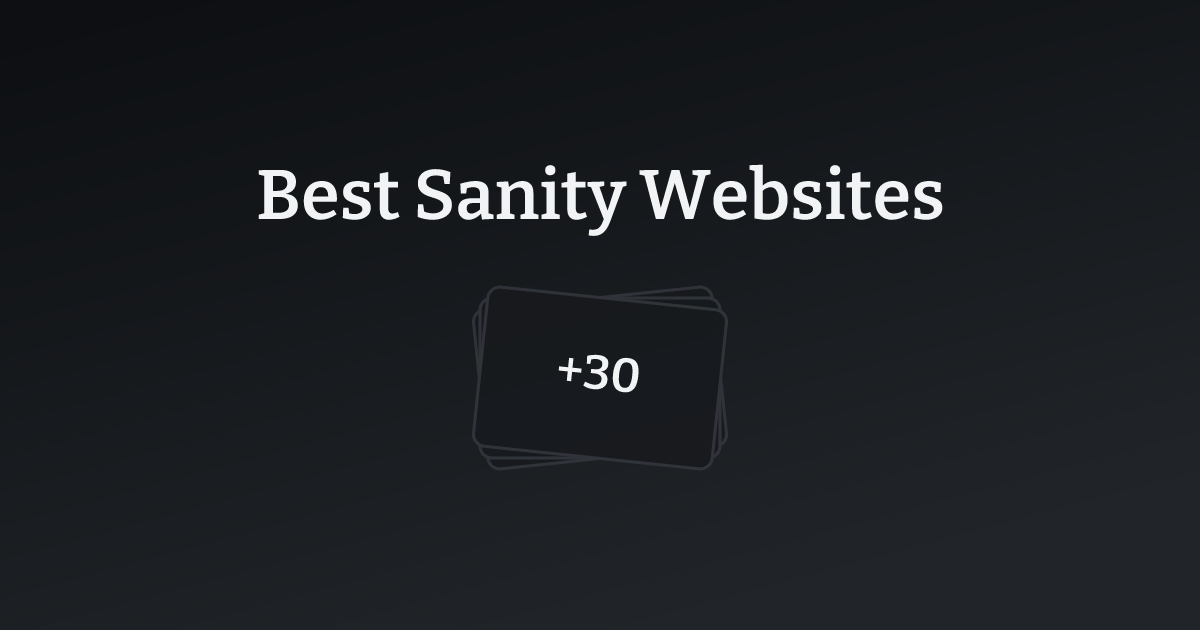30 Best Sanity Website Examples
I found the best Sanity websites to share for inspiration. Only 0.1% of reviewed website designs make it onto this list! Each website example includes a tall screenshot, a link to the live site, and the platform it was built on.

This sleek studio pairs bold sans-serif typography with a sharp black-and-white palette to deliver a modern, no-nonsense vibe for serious web developers.

This tech-forward platform strips away complexity with bold, minimalist copy that promises developers speed and efficiency in multiplayer app creation.

This Sanity-powered furniture site pairs clean navigation with a full-width hero showcasing Endy's cozy mattress bundles and minimalist product showcase layout.

Ingeno transforms businesses with AI and IoT expertise, delivering innovative digital solutions for modern enterprises seeking competitive advantage.

Animoto simplifies video marketing with an intuitive drag-and-drop editor perfect for busy creators and businesses.

Sanity's sleek dark-blue interface and modern sans-serif typography create a professional, tech-forward aesthetic that speaks directly to developers.

This scholarly publishing platform delivers trusted, research-driven content through clean design and strategic CTAs that appeal to academic professionals seeking career advancement.

Cliik's modern container shop delivers clean, stackable storage solutions for organized living spaces.

Cloudflare
Cloudflare's sleek black-and-white design with bold orange accents delivers a modern, professional aesthetic that speaks directly to developers and tech innovators.

This community resource hub empowers Maricopa residents with essential local services through clean, supportive design and intuitive navigation.

This dog-aging educational site welcomes pet owners with friendly design and clear explanations of breed, size, and genetic factors affecting canine longevity.

This accountancy site nails it with bold yellow accents, a clean horizontal nav, and a hero that layers text over striking imagery to build instant trust.

Eat Kernel
Eat Kernel's bold "Come and Get It" headline and crunchy copy punch through with urgency, pulling young food lovers into a fresh, vibrant dining experience.

Eurostar's bold, price-focused copy turns wanderlust into action with affordable destination deals and a crystal-clear call to book fast.

This artist's playful copy and bold colors invite fans into an exclusive community through a fun, casual newsletter pitch.

This marketing automation platform uses bold green accents and modern design to help businesses transform one-time buyers into loyal, returning customers.

StereoLabs
StereoLabs nails minimalist tech design with a sleek horizontal nav and full-screen hero that puts their cutting-edge 3D imaging hardware front and center.

This golf blog breaks down the sport for complete beginners with a clean design and personalized practice plans that actually make learning fun.

This serene photography journal transforms travel moments into a gallery-like experience through clean grids and calming natural aesthetics.

This travel site uses bold purple and orange gradients to make visa-free exploring feel thrilling and totally within reach.

PDF.co makes automating PDF workflows painless with its AI-powered API, perfect for developers who want to ditch manual processing.

Eric Hu Studio commands attention with bold typography and vibrant graphic illustrations that blur the line between fine art and commercial design.

Ridwell makes sustainable living feel effortless with straightforward copy that turns guilt-free recycling into a simple, guilt-free routine.

Loom's sleek video messaging platform empowers teams and businesses to communicate faster with AI-powered recordings that boost productivity and collaboration.

ZERA cuts through the noise with bold, confident copy that positions them as the trusted digital partner your business actually needs.

Stytch cuts straight to the point with "Developer-first passwordless authentication"—a bold, jargon-aware headline that speaks directly to its technical audience without fluff.

This clean-lined health insurance site uses bold typography and split-screen hero layout to make complex coverage feel refreshingly simple and transparent.

This German tattoo studio directory uses bold, edgy copy and a minimalist layout to connect artists with clients seeking customized ink experiences.

Create Today curates elite web design inspiration with a clean, modern aesthetic blending black, white, and green into a professional, gallery-style showcase.
About this collection
This is a collection of websites organized by the platform they are built on, category, and sometimes tags and the creator. They're here for inspiration. Most websites made it into this collection because they have beautiful designs, while others showcase exceptional copywriting or information architecture.
What this page contains

This page showcases 30 website examples built with Sanity. Each website includes a tall screenshot, a link to the live site, the platform it was built on, and a description (generated with AI).
Quality may vary by category or platform
Some sites aren't an absolute 10/10, but they shine relative to their categorization. For example, categories like Notary or HOA don't reach the same design heights as Designer or SaaS sites. They're still included so people in those industries have relevant references when building their website.
How these websites are picked
While I won't reveal the exact details of my curation process (so competitors can't copy), I can share that:
- They are all organically sourced (i.e., I don't copy other inspiration galleries)
- It's an arduous process to find these gems. I typically review 10,000 sites to discover just 10 worthy additions.
The purpose of this collection
There are two primary reasons people view these website examples:
- To find design, copy, or general website inspiration from similar businesses in their industry
- To explore the capabilities of website platforms before making a decision
Oh yes, and affiliate marketing. I'm part of affiliate programs for some of the platforms, so if you purchase after clicking a link, I may earn a commission.
Want to suggest a site?
Reach out to me on LinkedIn.
